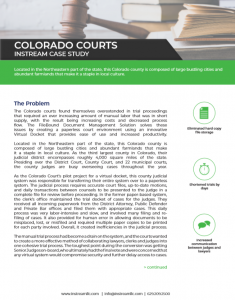Case Study: Colorado Courts
THE PROBLEM
The Colorado courts found themselves overextended in trial proceedings that required an ever-increasing amount of manual labor that was in short supply, with the result being increasing costs and decreased process flow. The FileBound Document Management Solution solves these issues by creating a paperless court environment using an innovative Virtual Docket that provides ease of use and increased productivity. Located in the Northeastern part of the state, this Colorado county is composed of large bustling cities and abundant farmlands that make it a staple in the local culture. As the third-largest county in Colorado, its judicial district encompasses roughly 4,000 square miles of the state. Presiding over the District Court, County Court, and 22 municipal courts, the county judges are busy overseeing cases throughout the year. As the Colorado Court’s pilot project for a virtual docket, this county judicial system was responsible for transferring their entire system over to a paperless system. The judicial process requires accurate court files, up-to-date motions, and daily transactions between counsels to be presented to the judge in a complete file for review before proceeding. In the former paper-based system, the clerk’s office maintained the trial docket of cases for the judges. They received all incoming paperwork from the District Attorney, Public Defender, and Private Bar offices and filed them with appropriate cases. This daily process was very labor-intensive and slow and involved many filing and refiling of cases. It also provided for human error in allowing documents to be misplaced, lost, or misfiled and required multiple paper copies to be printed for each party involved. Overall, it created inefficiencies in the judicial process. The manual trial process had become a drain on the system, and the courts wanted to create a more effective method of collaborating lawyers, clerks, and judges into one cohesive trial process. The toughest point during the conversion was getting Senior Judges on-board, who ultimately had the final vote and were concerned that any virtual system would compromise security and further delay access to cases.
THE SOLUTION
In creating an electronic solution for the courts, one of the biggest challenges was designing a process that was easy to use, reliable, and efficient enough to quickly gain buy-in from the judges. FileBound created the winning strategy by designing a Virtual Docket. This electronic version of the trial docket allowed judges immediate access to all cases and documents on a computer. By logging in, they could view all files, pending motions, and case decisions as they were made. Clerks could log in and update cases as needed, giving Judges access to cases anytime, anywhere. And with a secure connection, password sensitive access, and documents stored on in-house resources, the Judges were comfortable with the security of the solution. The second innovative feature that accelerated the adoption of the FileBound Solution was the ability to import documents using paperless processes. Instead of receiving each attorney’s paperwork and filing it with appropriate cases, FileBound allowed them to electronically import documents into the Virtual Docket which allows filing and updates to cases to take place automatically. To further extend the automation FileBound also provides the ability to use e-signature pads. During the court process, all associated parties must sign documents, and FileBound allows them to do so electronically. The signature automatically imports to the Virtual Docket and eliminates the need to have physical copies signed during every trial. This allows the docket to be a complete register of all ongoing cases. The efficiencies provided by the new system freed the clerks from many of the tedious processes that the old system required and allowed them to assist judges in more useful ways.
THE RESULTS
The largest benefit the court has seen is the unification of the trial court process. Incorporating all processes into one system gives the judges continual access to the latest information in the cases they oversee. It has streamlined the trial process for all parties involved and created a more efficient system. It provides instant retrieval of archived records and has eliminated the hassle of managing paper files and documents.
This streamlined process has helped in several other areas as well:
- Shortened actual trial by days
- Increased communication between lawyers and judges
- Reduced amount of papers printed
- Eliminated hard copy file storage
Though the complete benefits are hard to quantify, it’s fair to say the solution was a huge success. The Virtual Docket and FileBound paperless importing have turned the Senior Judges from observers to active participants and has allowed the whole court to run more efficiently, without adding additional resources.
Download the Full Case Study Below
